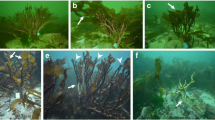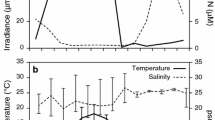Abstract
The seasonal growth of the brown alga Laminaria hyperborea (Gunn.) Foslie, which forms dense forests in the sublittoral zone of Helgoland, a rocky island in the Southern North Sea, was investigated by transplanting specimens of medium size onto PVC or wooden plates fixed to sub-tidal grwoth stations. The 2-year study revealed that, during the season of fast growth (January to June), young plants produce each year a new frond, larger in size than in the preceding year. This observation can be interpreted, in part, by assuming that the growth of the young frond is accomplished not only by its own assimilatory surplus, but also by reserve materials of the old frond assimilated during the preceding season of slow growth. This assumption is supported by experimental evidence: (1) Even in complete darkness Laminaria hyperborea is capable of producing a small new frond during the season of fast growth; (2) New fronds with stipe, but without old frond, grow (during the same period) considerably faster than isolated new fronds separated from the possible sources of reserve materials. Maximum growth occurs in normal plants which possess their old frond until April or May.
Similar content being viewed by others
Literature cited
Black, W. A. P.: The seasonal variation in weight and chemical composition of the common British Laminariaceae. J. mar. biol. Ass. U.K. 29, 45–72 (1950).
— and E. T. Dewar: Correlation of some of the physical and chemical properties of the sea with the chemical conditions of the algae. J. mar. biol. Ass. U.K. 28, 673–699 (1949)
—, W. D. Richardson and F. T. Walker: Chemical and growth gradients of Laminaria clcustoni Edm. (Laminaria hyperborea Fosl.). Econ. Proc. R. Dubl. Soc. 4, 137–149 (1959).
Clendenning, K. A.: Photosynthesis and growth in Macrocystis pyrifera. Int. Seaweed Symp. 4 (Biarritz), 55–65 (1961).
Kain, J. M.: Aspects of the biology of Laminaria hyperborea. 2. Age, weight and length. J. mar. biol. Ass. U.K. 43, 129–151 (1963).
Neushul, M. and F. T. Haxo: Studies on the giant kelp Macrocystis. 1. Growth of young plants. Am. J. Bot. 50, 349–359 (1963).
North, W. J.: Experimental transplantation of the giant kelp Macrocystis pyrifera. Int. Seaweed Symp. 4 (Biarritz), 248–255 (1961).
Parker, B. C.: Translocation in the giant kelp Macrocystis. Science, N. Y. 140 (3569), 891–892 (1963).
Sargent, M. C. and L. W. Lantrip: Photosynthesis, growth and translocation in a giant kelp. Am. J. Bot. 39, 99–107 (1952).
Sundene, O.: The implications of transplant and culture experiments on the growth and distribution of Alaria esculenta. Nytt. Mag. Bot. 9, 155–174 (1962).
—: The ecology of Laminaria digitata in Norway in view of transplant experiments. Nytt. Mag. Bot. 11, 83–107 (1964).
Svendsen, P.: Regrowth of Laminaria hyperborea after harvesting. Int. Seaweed Symp. 6 (Santiago de Compostela), (1968) (In press).
Author information
Authors and Affiliations
Additional information
Communicated by O. Kinne, Hamburg
Rights and permissions
About this article
Cite this article
Lüning, K. Growth of amputated and dark-exposed individuals of the brown alga Laminaria hyperborea . Marine Biol. 2, 218–223 (1969). https://doi.org/10.1007/BF00351143
Accepted:
Issue Date:
DOI: https://doi.org/10.1007/BF00351143




